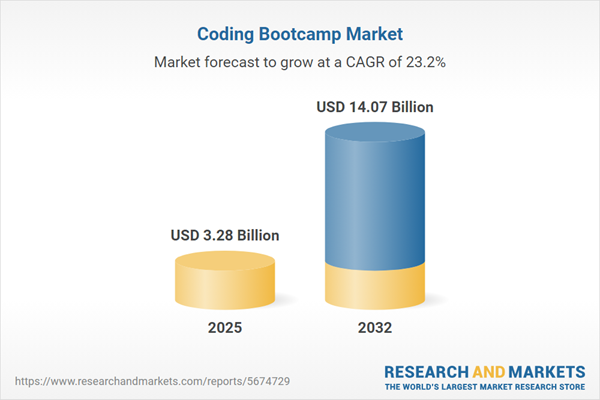Speak directly to the analyst to clarify any post sales queries you may have.
The coding bootcamp market is rapidly transforming organizational digital capabilities by enabling enterprises to develop the technical skills necessary for workforce modernization, helping senior decision-makers maintain competitiveness in dynamic environments.
Market Snapshot: Coding Bootcamp Market Size and Growth
In 2024, the global coding bootcamp market is valued at USD 2.65 billion, with projections indicating growth to USD 3.28 billion in 2025. Sustained by a compound annual growth rate (CAGR) of 23.19%, the market is expected to reach USD 14.07 billion by 2032. This momentum results from organizations prioritizing digital workforce development, particularly within finance, healthcare, and retail sectors. Companies are increasingly leveraging coding bootcamp providers to address digital talent challenges and close gaps in competencies such as cybersecurity, DevOps, and user experience design. Flexible curriculum delivery, diverse payment structures, and adaptable program formats support organizations in adapting to rapid technology shifts and changing business needs.
Scope & Segmentation: Coding Bootcamp Market Offerings
- Program Types: Back-end engineering, advanced data science with Python and R, cloud-based DevOps, full-stack and front-end development, and UI/UX design programs empower organizations to accelerate innovation and align learning with digital transformation targets.
- Delivery Modes: Hybrid courses, on-campus classes, interactive online formats, and on-demand modules provide organizations with versatile upskilling channels, supporting both centralized and geographically dispersed teams.
- Payment Models: Income share agreements, upfront payment plans, tiered services, and subscription pricing offer organizations flexibility in aligning training investments with budget timelines and workforce planning cycles.
- Course Durations: Intensive bootcamps under twelve weeks and extended learning tracks accommodate rapid skills acquisition or ongoing workforce development, letting organizations choose pacing that fits operational demands.
- Target Audiences: Programs are designed for organizations leading digital transformations, working professionals seeking technical proficiency, and students preparing for digital career roles. Both new and seasoned staff benefit, regardless of educational background.
- Geographic Regions: Market adoption spans the Americas, Europe, the Middle East, Africa, and Asia-Pacific. Leading providers localize content and delivery to reflect regional regulatory requirements and priority digital skills.
- Leading Providers Profiled: Major market participants include Bloom Institute of Technology, General Assembly, Springboard, Thinkful, Flatiron School, CareerFoundry, Le Wagon, Ironhack, Coding Dojo, and App Academy, each tailoring curricula to industry and regional organizational needs.
Coding Bootcamp Market: Key Takeaways for Senior Decision-Makers
- Customizable coding bootcamp programs enable organizations to bridge skills gaps and align talent development with sector objectives.
- Hybrid and digital delivery options make continuous workforce development highly accessible, supporting seamless upskilling for globally distributed teams.
- Adaptive payment plans allow companies to manage training investments flexibly as workforce requirements and financial cycles evolve.
- Strategic partnerships with bootcamp providers grant access to active alumni networks and industry collaborations that enhance internal mobility and recruitment.
- Regular curriculum updates support technology standard compliance and help organizations stay competitive in a fast-evolving digital landscape.
- Localized course content allows multinational firms to address compliance and workforce needs specific to different countries and regions.
Tariff Impact: Infrastructure Adjustments in Bootcamp Delivery
Recent tariffs on electronic hardware have driven U.S. coding bootcamp providers to transition from traditional in-person computer labs to cloud-based virtual laboratories. This shift decreases reliance on physical facilities, broadens access for remote learners, and enables the development of scalable, enterprise-focused training solutions tailored to meet diverse organizational demands.
Methodology & Data Sources
This report is based on executive and instructor interviews, graduate survey data, and focused research involving HR leaders. Insights are confirmed through reputable market intelligence and public disclosures, ensuring they are actionable for workforce planning and digital capability development.
Why This Report Matters for Senior B2B Leaders
- Supports data-driven strategies for digital upskilling and talent planning tailored to unique organizational objectives and industry needs.
- Enables benchmarking of employee development programs, supporting organizational agility and effective response to technology advances.
- Delivers practical insights to help mitigate risks associated with digital infrastructure and maintain operational continuity through workforce change.
Conclusion
Coding bootcamps provide organizations with effective pathways for workforce and technology adaptation. Leaders can leverage these insights to shape sustainable skill-building strategies and maintain high-performing teams in dynamic digital markets.
Additional Product Information:
- Purchase of this report includes 1 year online access with quarterly updates.
- This report can be updated on request. Please contact our Customer Experience team using the Ask a Question widget on our website.
Table of Contents
3. Executive Summary
4. Market Overview
7. Cumulative Impact of Artificial Intelligence 2025
Companies Mentioned
The companies profiled in this Coding Bootcamp market report include:- Bloom Institute of Technology, Inc.
- General Assembly, Inc.
- Springboard, Inc.
- Thinkful, Inc.
- Flatiron School, Inc.
- CareerFoundry GmbH
- Le Wagon SARL
- Ironhack S.L.
- Coding Dojo, LLC
- App Academy, Inc.
Table Information
| Report Attribute | Details |
|---|---|
| No. of Pages | 196 |
| Published | November 2025 |
| Forecast Period | 2025 - 2032 |
| Estimated Market Value ( USD | $ 3.28 Billion |
| Forecasted Market Value ( USD | $ 14.07 Billion |
| Compound Annual Growth Rate | 23.1% |
| Regions Covered | Global |
| No. of Companies Mentioned | 11 |









